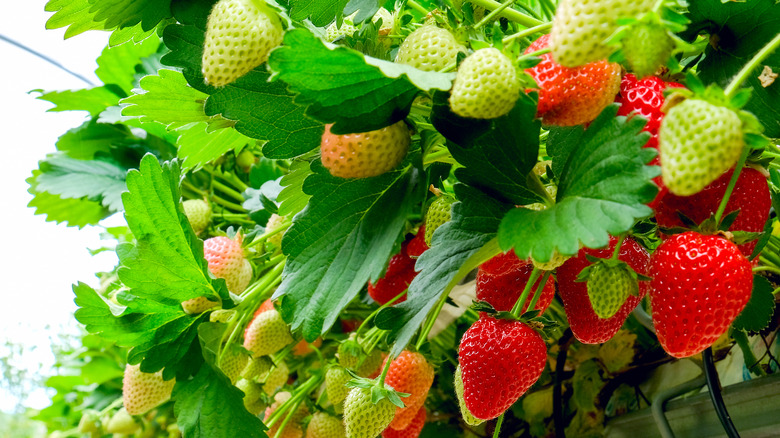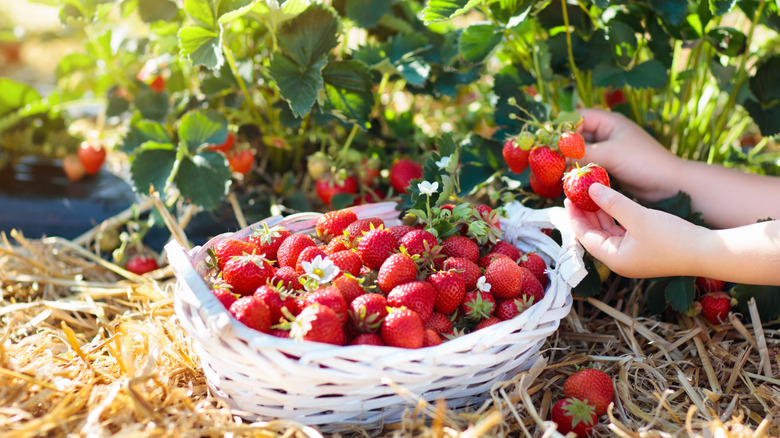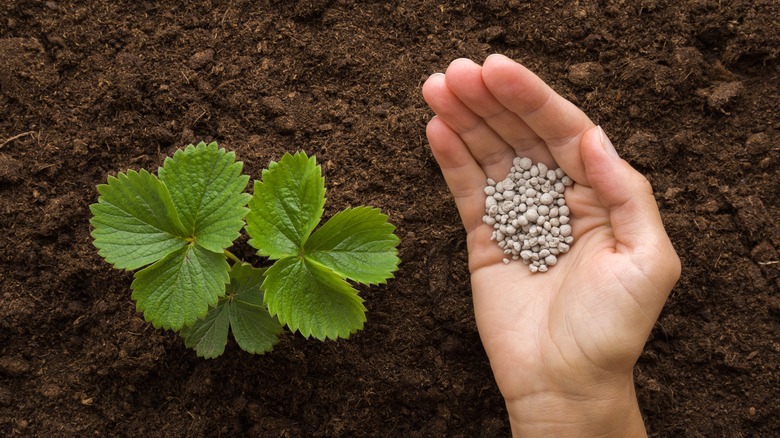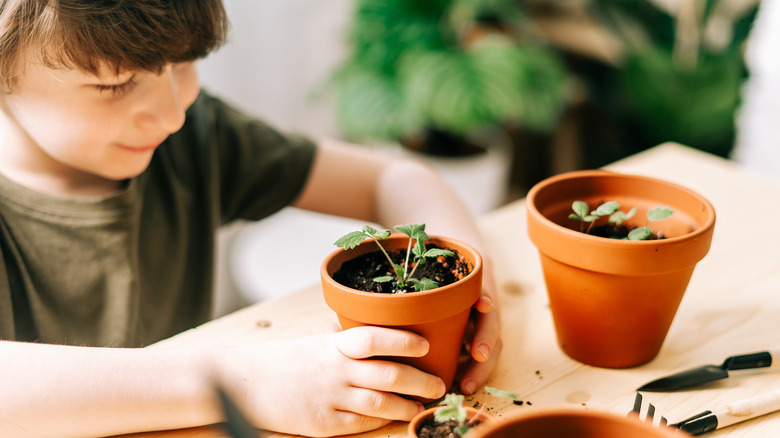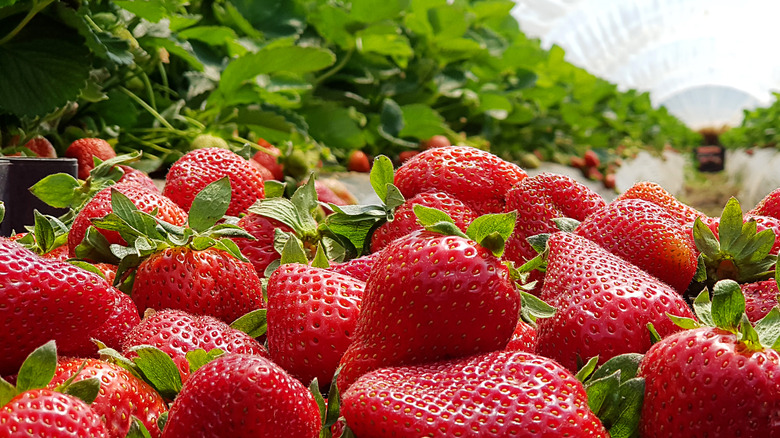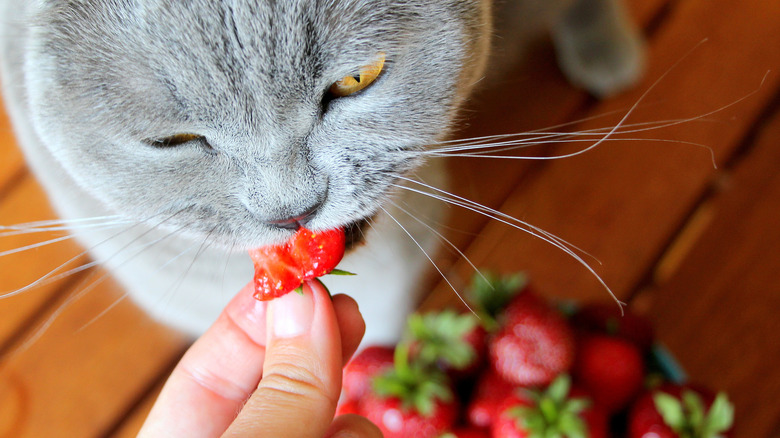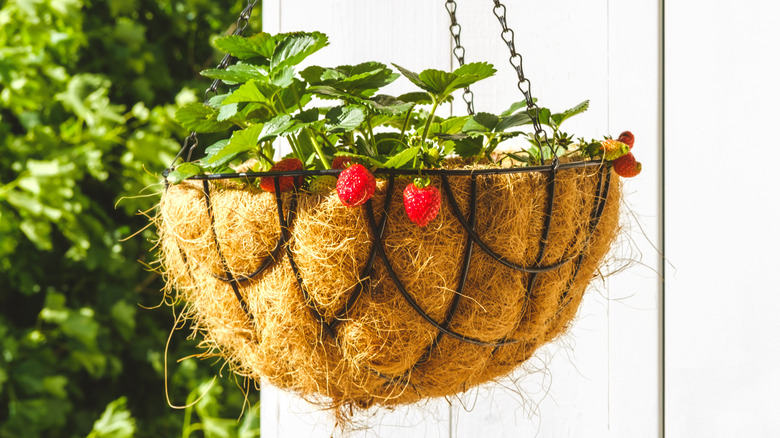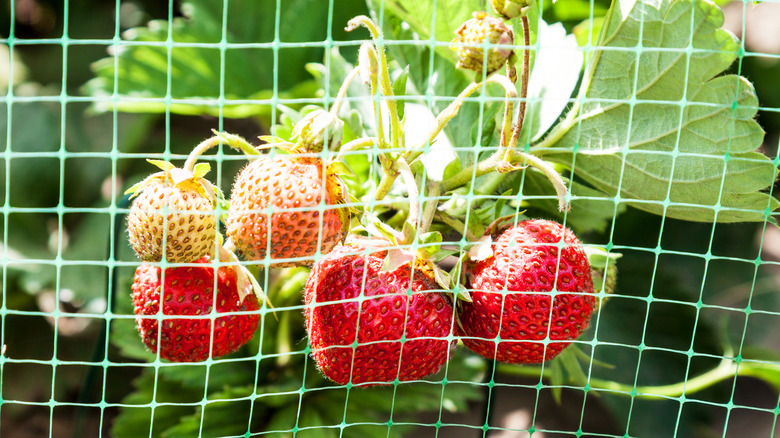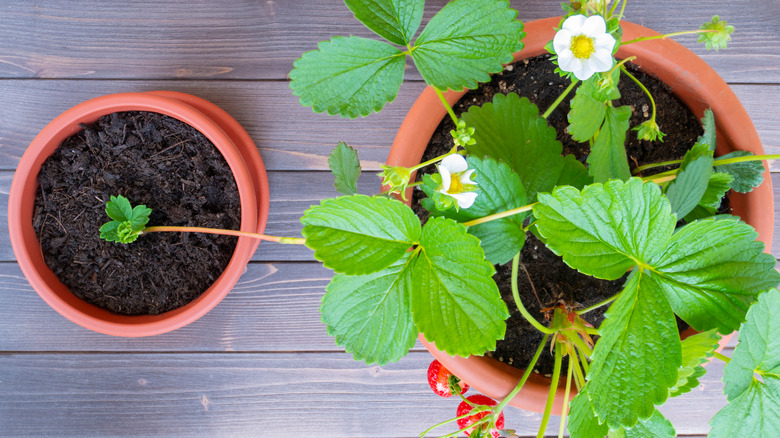How To Grow And Care For A Strawberry Plant
Sweet, juicy, and delicious. Whether baked or dipped in chocolate, strawberries have been consumed for centuries, but how can you grow this delightful plant at home? A hybrid species, the modern garden strawberry, or Fragaria x ananassa, is the red, jammy perfection we love and use today in so many dishes. Early woodland strawberries may not have captivated people's taste buds, as they were minor and coarse, lacking luscious flavor, The University of Vermont notes. Not a true berry, cultivation of the aggregated fruit plant progressed in Europe by the 14th century leading to the combination of the Virginian and Chilean ancestral varieties. Gradually, the English produced more strawberry plant varieties from seeds in their gardens, thus spreading its sweet reputation throughout the world.
Fun to pick, strawberries are not generally fussy about where they are placed. The perennial is easy to grow and care for; simply give it a sufficient supply of water and sunlight. A strawberry plant may grow 6 to 12 inches in height and 1 to 2 feet in width, producing quality fruit for a year following planting. A healthy plant has leafy green foliage and red fruit bunches that dangle over the side, and according to Bonnie Plants, strawberries may last only a few years as their fruit production decreases with time. Darling buds actively bloom in summer and ease off during the fall and winter to then start the process again. Read on to learn more about growing a strawberry plant of your own!
How to use a strawberry plant in the garden
Strawberry plants are fun! They love to roam in the dirt and bask in the sunshine, especially in summer. Make sure to place them where they will receive at least six hours or more of sun exposure and somewhere in the open air without an enclosure. They are self-fertile, meaning they have both male and female parts to jumpstart pollination. According to Vegetable Growers News, the combination of rain and wind can also motivate pollen within the plant's flowers but require the assistance of bees to finish the job. When lacking pollination, your berries may turn out looking underdeveloped.
Strawberries are social in the garden; you can plant them nearby other vegetables like asparagus, spinach, lettuce, garlic, horseradish, and onion. Legumes like beans and peas are also good companions, as they help enhance the soil by balancing the strawberries' nitrogen needs for growth, per Homes & Gardens. Other friendly herbs and plants to consider are borage, chives, and thyme, as well as marigold, a great bug and weed repellent for many fruits and vegetables. Your strawberries are ready to be picked and harvested when they look vibrantly red or fully white, depending on the variety you grow.
How to grow a strawberry plant
Pie, jam, smoothies — imagine the delicious treats you can make with home-grown strawberries! As versatile as the fruit is, so is the plant. Strawberries can grow year-round in USDA zones 5-8 and 9-10 in the cooler season. These plants grow well potted, in the ground, in raised beds, propagated, or from seeds. If planting more than one, place them 12 to 18 inches apart in well-draining acidic soil (pH between 5.5 and 6.8). Depending on your zone, the best time to plant is in the spring after the last frost. Position your root bundles vertically in a container at least 6 inches deep. If the roots are too long, trim them down to 4 or 5 inches, and ensure the crown is even with the soil line. For an extra boost, add compost tea, a blend of compost and water, after planting or harvesting, Old World Garden Farms recommends.
If planting from seeds, there's a cold process to follow. First, chill some seeds in the freezer for a few weeks, remove them, and sit until room temperature. Then, scatter and press them gently into moist potting soil in trays and place them under grow lights to promote germination. This may take a few days to several weeks, as strawberries need that delicate light to develop, per The Spruce. Once sprouted, look for a trinity of leaves; then, it's time to transplant into a larger container.
How to care for a strawberry plant
It's important to understand how a strawberry plant works when growing it. With abundant blooms that start in the spring, strawberries will typically bear fruit from April to June (February in Florida). Several baby foliage will emerge once the fruit is flourishing, and depending on the type, they remain attached to the original plant, per Bonnie Plants. Strawberries need light to produce fruit, so don't let them shy away from the sun. Yes, too much heat will exhaust them, but they require six to eight hours of direct sunlight a day. In addition, you can help the plant retain moisture by adding mulch around the surface without crowding the leaves.
With shallow roots, water your plant deeply and whenever the soil looks dry, without burying the crown. Water generously to promote secure roots (1 to 1.5 inches weekly), but don't let the little buds grow into full strawberries at first. According to Growing in the Garden, it's best to clip them off to enforce strength and growth for nice plump strawberries to emerge later. You might let the runners spread out for more fruit production, or you can remove them for bigger quality strawberries to develop, but ensure to remove weeds and dead leaves throughout the process. It's time to use fertilizer when the foliage appears too yellow or if no fruit or flowers have developed. Applying a fertilizer like organic compost will enrich the soil's nitrogen, phosphorus, and potassium for ultimate flavor.
Strawberry plant varieties
Depending on the number of strawberries you want to produce, there are three main types to consider planting: June-bearing (one large annual crop), ever-bearing (all season; two to three times per year), and day-neutral (they have peak times throughout the summer months). Strawberries grow in most regions of the United States, and according to The Spruce Eats, there are over 600 varieties among these three types. Here are six popular kinds to consider:
- Alpine (Fragaria vesca) — Known in France as fraises des bois, this subtle little strawberry can be expensive because of its small production. However, it can thrive in the shade and mostly bears fruits during the mid-summer.
- Allstar (Fragaria) — June-bearing strawberries, these growing giants have a classic strawberry shape with shine and durability. They are well-liked among gardeners and produce plentiful in late mid-season.
- Honeoye (Fragaria) — This variety is a June-bearing strawberry that is highly produced worldwide and features bright orange-red fruits.
- Jewel (Fragaria) — This plant is a favorite among picking farms and local markets, and produces fruit in late to mid-season, per Strawberry Plants.
- Ozark Beauty (Fragaria x ananassa) — The most popular ever-bearing plant, this type is abundant in early and late summer crops.
- Sparkle (Fragaria ananassa) — This variety is the best choice for making jams. It has a rich red color and delicious flavor and is highly dynamic as it helps extend the fruit season for others.
Is the strawberry plant toxic?
Rich in vitamin C and antioxidants, strawberries provide a plethora of health benefits for your brain and heart. Although growing your own strawberry plant gives you quick access to them, there are other potential dangers to be aware of when it comes to people and pets. For humans, allergies and hives may show up by either ingesting the fruit or even from handling the plant, per Gardening Know How. Symptoms can be subtle, like a rash to something more severe that may require medical attention. Things to look out for are itching, swelling, and wheezing. If needed, take the right precautions like wearing gloves when handling, swallowing an antihistamine or having an epi-pen on hand.
With pets, cats can eat strawberries themselves, as the fruit is not poisonous to them, but it's not something that they should indulge in. What about the foliage? According to Great Pet Care, the leaves and stems are not toxic, although eating them might cause an upset stomach with vomiting. So, be cautious with allowing pets to munch on these. The same goes for dogs, which can suffer from diarrhea, abdominal pain, and fatigue when consuming the foliage. Also, be aware of strawberries as a choking hazard for dogs that can't chew well, especially smaller canines.
How to repot a strawberry plant?
Not typically grown from seeds, potted strawberry plants are usually available all year long at your local garden centers; you may even try bare-root runners taken from the wild. If your potted plant is well-established and producing fruit, you can repot it in early spring or winter by the earliest, per Home For The Harvest. This will rejuvenate it for the coming year, and it's a fantastic time to replace older roots with young plant runners. Remove it gently, shake off any excess dirt, and place it in the new container at least 6 inches deep. Add some fresh compost or straw mulch to revitalize and keep weeds and pests limited.
If you're using a hanging basket, choose a variety that produces small berries and does not run. For example, June-bearing strawberry plants are not as successful for baskets as day-neutral plants, whose summer and fall blooms will be better manageable in hanging pots, Gardening Know How notes. Some good day-neutral varieties to try are Tristar, Tribute, Albion, and Alpine, which can thrive in partial shade.
Pests and diseases in a strawberry plant
Small pests love the sweet juiciness of strawberries as much as we do. Some examples of varmints are aphids, armyworms, Japanese beetles, loopers, spider mites, slugs, spittlebugs, and weevils. To eliminate contact, remove dead leaves averting common hiding places. You could also place citrus rinds around the plant, as they will be attracted to those first. There are also several other approaches that prevent various types of bugs from hindering your strawberries. First and foremost, keep the area clean, including removing rotten fruit (which attracts beetles), and limiting the lure of many bugs, The Spruce advises. Birds, like finches, robins, and sparrows, are another predator that can cause damage to your urban patch; they will peck at the strawberries, leaving holes, or eat them whole. On that end, birds can damage urban patches more than commercial farms, so whatever size your crop is, you might cover it with bird-resistant cloth-like mesh netting.
Avoid watering too often because it can attract slugs; replenish deeply, but less frequently. If overwatered, gray mold may appear, attacking both the fruit and vegetation, which is one of the most prevalent diseases among strawberries. According to Patch, if your strawberry plant isn't receiving enough hydration, the leaves will show powdery white mildew; to ensure your crop is healthy, try applying a fungicide and removing those leaves. Make sure the plants receive enough sun and air circulation as well.
Runners and propagation
Easy to propagate, there are several ways to spread the wealth of your strawberry plant, and it starts with the long, extensive shoots called runners, also known as stolons. Once you see a runner beginning to sprout slightly at its node, it's ready to get established elsewhere. Fill a 3 to 4 inches container with moist peat or soil, then lightly submerge the runner into it and stabilize it with a rock, wire, or other handy material. Let it get root bound up for four to six weeks; then, you can snip it from the parent plants. If your plant is in a spacious bed, simply pin the node down into the soil to take root with metal U-shaped pegs as runners naturally create a second row following the first. Gardeners can also manage the new direction of growth, Rural Sprout says.
According to CaliKim29 Garden & Home DIY, you might also try propagating your strawberry plant by placing your elongated runner in a small plastic bag. Fill the bag with a small amount of wet soil and poke holes for circulation. Wrap it up gently and wait a couple of weeks or until a few leaves appear at the top. If you see long generous roots, it's ready to be placed in a starter container. Using your current strawberry plant runners for propagation is an organic way to produce more strawberry plants. Most all varieties produce stolons and should be propagated every few years.
